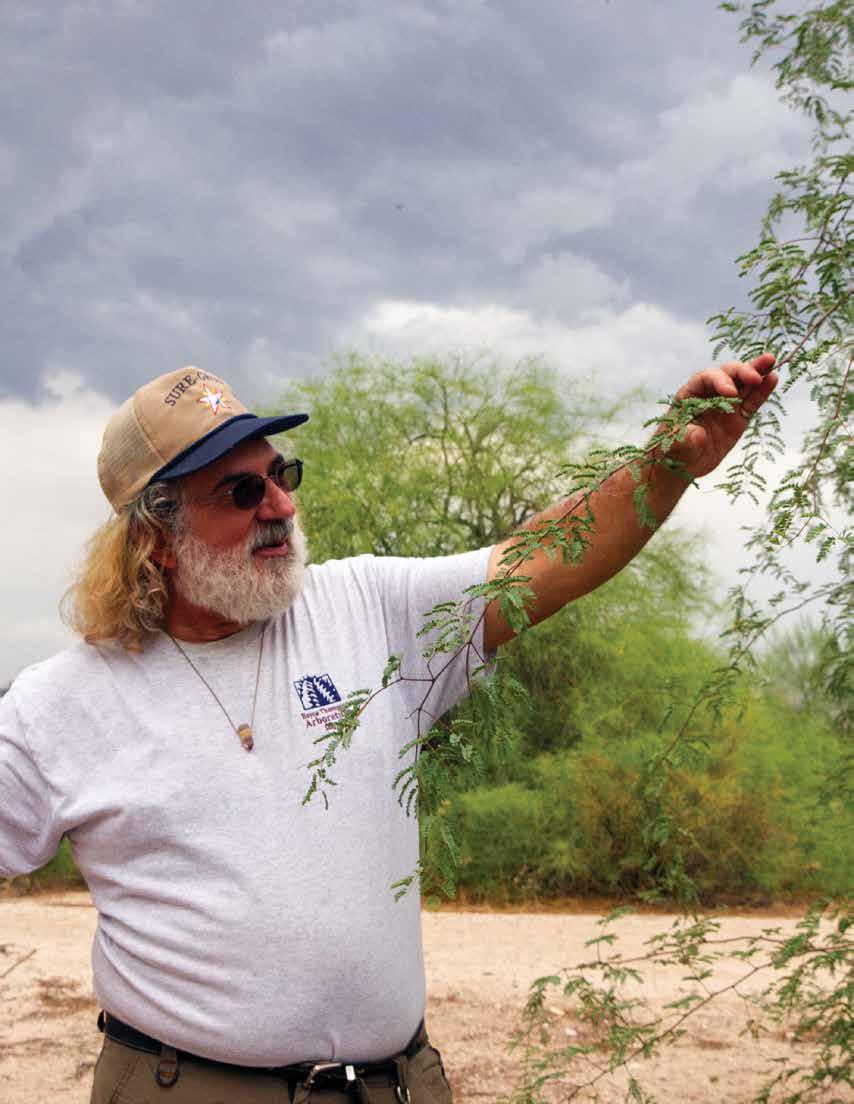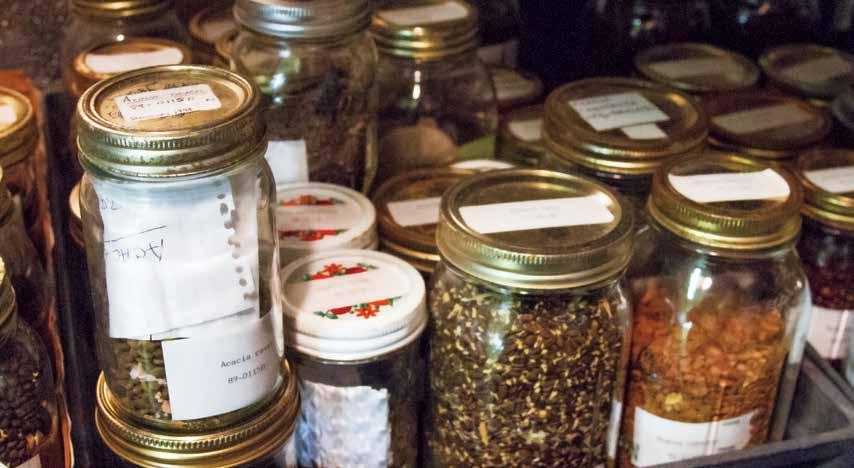
6 minute read
A 30-Year Seed Bank Community
TEXT AND PHOTOGRAPHY BY DARA HEWARD
The Desert Legume Program grows desert legumes in Tucson - and even a bigger global community.
Advertisement
If legumes weren’t around, we wouldn’t have many of the benefits that they provide. After all, they are the second most important plant family agriculturally. These benefits are wide ranging: nitrogen fixation; providing nutritional benefits for humans and livestock; improving soil quality; helping provide nitrogen availability for crops; countless medicinal benefits; and in usage as low-water landscape plants. Plus, the scientific name is outright fun to pronounce, similar to a Harry Potter spell: Leguminosae (alternatively Fabaceae).
With the Desert Legume Program (DELEP), we have many species of legumes from the arid landscape regions of the world saved and put aside for research and conservation. As a joint venture of the Boyce Thompson Arboretum and The University of Arizona College of Agricultural and Life Sciences, DELEP is a very unique project. To learn a little more about DELEP, the seed bank, and the field sites (where a lot of these seeds come from), I took a trip down to Tucson, Arizona where they are housed. DELEP is located at the University of Arizona Campus Agricultural Center (CAC) and housed in the Arizona Crop Improvement Association building. They are neighbors to the USDA Bee Research Lab.
How cool, I thought, to have field sites of legume flowers so close to the bee lab, where bees could help pollinate DELEP’s plants and DELEP could help feed the bees. In Tucson, under the gray gloom of an Arizona monsoon, I walked into the DELEP offices. I greeted Ken Coppola, DELEP’s horticultural specialist. His office was covered in pictures of plants, naturally. Ken is a charismatic guy with a vibrant personality. Soon after, Matt Johnson walked in and greeted me. Matt is the Program Manager and Curator of DELEP, a tall man with a contagious smile. It’s a rarity and a delight when I see these two colleagues, since I work in Superior at the Arboretum and they are housed in Tucson. I’m not sure if I have more fun when they talk “plant talk”, saying the various names of surrounding plants, or when they fight over what plants need to be moved out of the shade house and field sites. It’s as if they speak their own language, in this case, we could call it “Legumish”.

Ken Coppola points out one of the many legumes at the DELEP field sites housed at the University of Arizona Campus Agricultural Center (CAC).
Ken took me on a tour of the field sites next. He took me to Field Site 1 and Field Site 3. Since his first day at DELEP, 30 years ago, Coppola has helped provide the support of age-old trees. I began to grasp the importance of these two colleagues and the role they had on the long-standing legume program. He not only knew every plant by its name and the year it was planted, but he kept data on each plant – how much each one flowered, how many seeds it produced, environmental factors of that year, how much water they received, how much wind they got, and so on and so forth.
While telling me about his day in the life of a DELEP horticulturist, he stopped and pointed out a dragonfly sitting on top of one of the shrubs, “See, this area is special for many reasons. Dragonflies come here time after time and use the field sites along with countless other wildlife. We do more than just research and conserve legumes. We provide a community for plants and wildlife.” He continued to tell me about each tree, “This one is a Rhynchosia pyramidalis. The Native American Pascua Yaqui Tribe used the seeds in ankle rattles.
There are about 250 known species of Rhynchosia and the Desert Legume program seed bank has 11 of them.” He then named another legume, an Acacia kempeana (Witchetty bush), an Australian Acacia. He told me that Australian Aborigines use the “wood” for making harpoons and obtaining grubs from the roots.
One thing that I noticed was how intricately Ken kept the field sites. By walking through the sites with him, I began to understand just how important he was to the continuation of DELEP. He has the history, the knowledge, the language, and most importantly, the enthusiasm. I felt like I got to know Ken better by sharing a stroll in his garden.
After working at the Arboretum for a year now, I have realized how special each horticulturist is to their area of specialization. The area, in a sense, becomes that person, whether that’s intricate, creative, passionate, full, modern and simple, meditative, strategic, etc. Each horticulturist has brought their own values to the gardens. With Ken, I could tell just by walking through the sites that he was very in tune with nature, natural cycles, understanding the weather, and really understanding each plant as an individual.
Ken told me about two different plants of the same species, one produced many seeds, the other did not. We discussed theories on why this could have happened. He continued to tell me each plant, not by name, but by their uniqueness. After, I told Ken how impressed I was with the program and his role in it, he said something that stuck with me, “The Desert Legume Program wouldn’t be possible without the long-term knowledge many of us have accumulated in the last 30 years. These plants and seeds depend on us.” I have known this all along, but seeing the work of the past 30 years manifest in person made me realize his statement was something to be shared.

Matt Johnson holding a big bean pod from Entada gigas, common names include sea bean, sea heart, and monkey ladder. It is a liana (woody vine) that is native to parts of tropical America and Africa. The seeds are often found on beaches after floating down rivers and into the ocean, and then washing ashore.
Back at the DELEP offices, Matt told me that he originally got into plants because one of his earliest memories was helping his mom in the garden with peas. Ever since, he’s been hooked.
A local of Tucson, Matt didn’t grow up far away from where he now works. He showed me his office. I turned the corner and immediately saw the biggest seed pod I have ever seen! “Is that real?!” Yes of course it’s real, I couldn’t expect anything less of Matt: keeping the coolest of legumes in his office because he has traveled all over the world collecting seeds for the Boyce Thompson Arboretum.
Next, he showed me the seed collection, Boyce Thompson Arboretum’s herbarium, and the lab where many seed germination experiments have taken place. Matt tells me that, just in the last month, there have been a record 20 seed requests. He showed me some of the requests – “This one is for four accessions of Lupinus argenteus being sent to a researcher at the Northern Arizona University School of Forestry, for use in a greenhouse study of the soil mesocosm in relation to plant performance in untreated vs. thinned and burned pine forest. This one is a request for Vigna vexillata to a researcher in South Africa at the University of the Western Cape Department of Biotechnology for genetic studies, to evaluate response of the plants to drought and heat stress.”

A glimpse into DELEP’s seed bank. The seeds are kept in either a big walk-in freezer or box freezers.
If there was one constant theme of the day, it was community. The community between the bees and the plants; the community of the research efforts between Boyce Thompson Arboretum and the University of Arizona; the community between the plants and the wildlife, which end up calling north central Tucson their home because of the field sites; and the global community, which depends on the survival and endless value of DELEP’s seeds in conservation and research.










